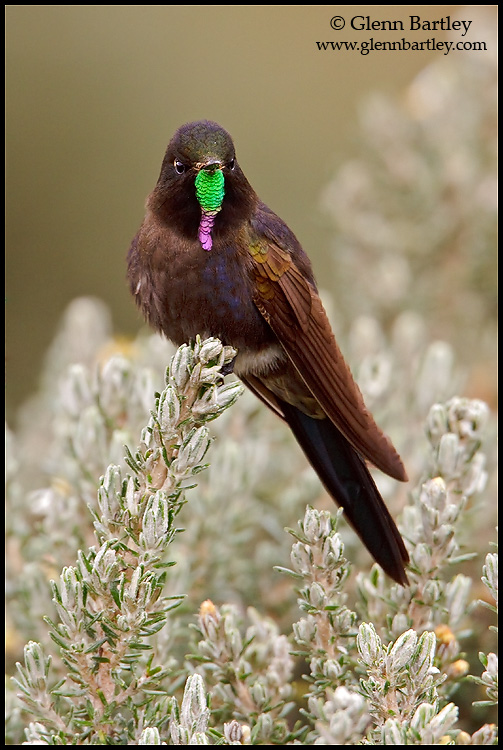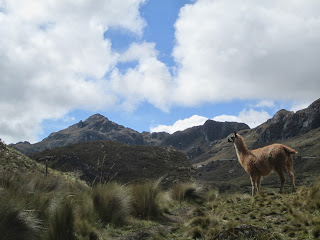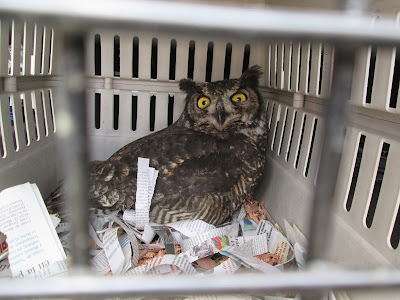Captain's Log, Day 54: Statistics for day trip to Cajas National Park on 29 October, 2013: 37 new bird species acquired, 12 km of trail explored, primary Andean Forest experienced for the first time.
The Andean Paramo. Home to Andean Condors, Spectacled (Andean) Bears, a gaggle of hard-to-see amphibians, extensive fishing and ranching activity, ice melt streams and lakes, and of course...Andean birds.
Yesterday was my fist visit to the park. I jumped on the Trasporte Occidental around six, arrived just past seven, and spent the day birdwatching and admiring the spectacular views. The richness of the flora and fauna in the highlands here reminded me a lot of the high desert of Easter Oregon in the states...with more hummingbirds
, Tawny Antpittas, and llamas.
 |
| I got to explore some of the surrounding farmland, wandering for an hour before my bus arrived in the afternoon. There are different seedeaters and bird species in the surrounding cattle ranches. Ranching, unfortunately, is the main reason why only 1-3% of primary Andean forest remains today. |
 |
| Cajas is known for its cold. On most days, a fine mist and the cooler shelter of the forests here make the park's climate much colder...especially in the afternoons. There are a number of white crosses by trees at the park's entrance in remembrance of those who have died from the cold up here. |
 |
| I got lucky. It was spectacularly sunny yesterday. |
 |
It
was hard to get past the entrance! I almost spent an hour there
watching a band of Blue-mantled thornbills chase one another, and feed
on flowers on the ground. How WEIRD to see hummingbirds on the ground...
|
 |
| Here's a photo of one of said thorntails, found on google (credit to Glenn Bartley, as seen above). |
 |
| Sunny didn't really imply warm. A few layers were definitely necessary for my slow-paced bird walking. |
 |
| Looking back down towards Cuenca, over the valleys. |
 |
| The plant life was incredible. |
 |
| As were the birds. I walked for a while with one of the park guides (by the name of Wilmer), and he explained that people called the Tit-like Dacnis a `bluebird`--Azulero--here. Just like in the states, people in Cuenca see it as an omen of happiness. My Spanish professor told me to watch out for it during my visit. |
 |
| The reflections off the lakes were truly spectacular. |
 |
| Wilmer informed me that Cajas has 62 different lakes, many connected by streams and rivers. |
 |
| I love dizzying photos. The reflections were so clear. You can't see from this picture (but the ripples in the left corner leave a clue)-there are tons of trout in most of these ponds. In Cajas, they're mostly native species, but introduced species are common (and problematic to native species) in other parts of the highlands. |
 |
| These Polylepis trees are specific to Andean forests. The red was really striking in the sun by the lake. |
 |
| There were a few wayward llamas and alpacas combing the trails. Hehe. |
 |
| I was sad I didn't have time to explore more trails, but I took the closest one I could to a Polylepis woodland. My bird book had informed me that they're excellent places for mixed flocks of siskins, foliage-gleaners, and tanagers. It was right. |
 |
| Looking down over a small strand of Polylepis...some of the last remaining primary Andean forest in Ecuador. |
 |
| Fun fact: Quinoa comes from the Andean highlands. |
 |
| The richness of the high desert in Oregon always astounded me, and the Andean forest did the same. You can look over miles of open Paramo grasses and flowers, and then walk into a deliciously cool, moss-covered, bromeliad-heavy Polylepis forest. |
 |
| This is Spectacled Bear territory. They feed on the bromeliads! |
 |
| Another awesome colloquial name for the gregarious Tawny Antpittas: the Cho-chau, for their loud and characteristic call. They may have been my favorite spot of the day for those silly calls...check out the call here! |
 |
| Spectacular plant diversity along the streams bordering the forests. |
 |
| I watched a Variable hawk soar over the forest for some time. I have no words. |
 |
| I set my sights on a waterfall across the valley, made it over and onto the top of the second ridge of hills---and had to return, before the afternoon rain and fog came. |
 |
| I passed a few bridges and campsites. How cool would that be, to camp here---with the Paramo wolves (like coyotes), highland owls, nightjars, nocturnal mammals and stars? I may have to convince my friends here to come with me before I leave. |
 |
| Thanks for a beautiful day, Cajas. |
I would really recommend taking the time to explore Cajas if you ever go to Cuenca. There's an incredible amount of life in the Paramo, and it's a particularly striking kind of beautiful. I have to go back at least once more before I go.
There's just something about mountain terrain.
More about Cuenca life coming in the next few days! Stay tuned.
Cheers,
Nikki


































































